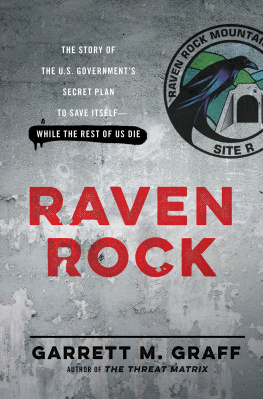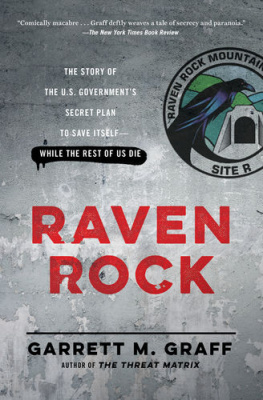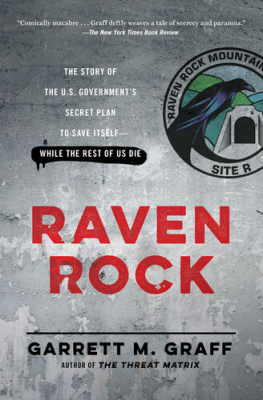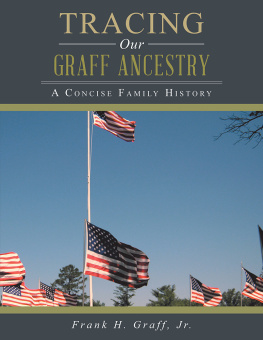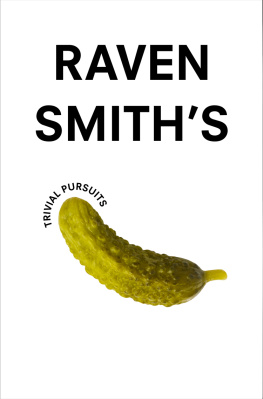Garrett M. Graff - Raven Rock: the story of the U.S. Government’s secret plan to save itself-while the rest of us die
Here you can read online Garrett M. Graff - Raven Rock: the story of the U.S. Government’s secret plan to save itself-while the rest of us die full text of the book (entire story) in english for free. Download pdf and epub, get meaning, cover and reviews about this ebook. year: 2017, publisher: Simon & Schuster, genre: Politics. Description of the work, (preface) as well as reviews are available. Best literature library LitArk.com created for fans of good reading and offers a wide selection of genres:
Romance novel
Science fiction
Adventure
Detective
Science
History
Home and family
Prose
Art
Politics
Computer
Non-fiction
Religion
Business
Children
Humor
Choose a favorite category and find really read worthwhile books. Enjoy immersion in the world of imagination, feel the emotions of the characters or learn something new for yourself, make an fascinating discovery.
- Book:Raven Rock: the story of the U.S. Government’s secret plan to save itself-while the rest of us die
- Author:
- Publisher:Simon & Schuster
- Genre:
- Year:2017
- Rating:4 / 5
- Favourites:Add to favourites
- Your mark:
- 80
- 1
- 2
- 3
- 4
- 5
Raven Rock: the story of the U.S. Government’s secret plan to save itself-while the rest of us die: summary, description and annotation
We offer to read an annotation, description, summary or preface (depends on what the author of the book "Raven Rock: the story of the U.S. Government’s secret plan to save itself-while the rest of us die" wrote himself). If you haven't found the necessary information about the book — write in the comments, we will try to find it.
Garrett M. Graff: author's other books
Who wrote Raven Rock: the story of the U.S. Government’s secret plan to save itself-while the rest of us die? Find out the surname, the name of the author of the book and a list of all author's works by series.
Raven Rock: the story of the U.S. Government’s secret plan to save itself-while the rest of us die — read online for free the complete book (whole text) full work
Below is the text of the book, divided by pages. System saving the place of the last page read, allows you to conveniently read the book "Raven Rock: the story of the U.S. Government’s secret plan to save itself-while the rest of us die" online for free, without having to search again every time where you left off. Put a bookmark, and you can go to the page where you finished reading at any time.
Font size:
Interval:
Bookmark:
We hope you enjoyed reading this Simon & Schuster ebook.
Get a FREE ebook when you join our mailing list. Plus, get updates on new releases, deals, recommended reads, and more from Simon & Schuster. Click below to sign up and see terms and conditions.
CLICK HERE TO SIGN UP
Already a subscriber? Provide your email again so we can register this ebook and send you more of what you like to read. You will continue to receive exclusive offers in your inbox.
Thank you for downloading this Simon & Schuster ebook.
Get a FREE ebook when you join our mailing list. Plus, get updates on new releases, deals, recommended reads, and more from Simon & Schuster. Click below to sign up and see terms and conditions.
CLICK HERE TO SIGN UP
Already a subscriber? Provide your email again so we can register this ebook and send you more of what you like to read. You will continue to receive exclusive offers in your inbox.
While this is the first comprehensive attempt to piece together the history of the Cold Wars Doomsday plans, many journalists and researchers have tackled parts of this story before me. Its been a long and tiring fight for many to force the government to release documents, figures, and information that seemingly bear little security risk anymore. Its a fight that dates back at least to January 5, 1982when I was just a few months oldwhen David Alan Rosenbergs seven-year fight to force the disclosure of the size of the U.S. nuclear arsenal scored its first win: The Department of Energy agreed to release the figures for the 1945 to 1948 yearsjust three years, numbers that even by 1982 were decades out of date.
Writing this book was racing a clockdeclassification on the one hand, but living memories on the other. The contributions of Rosenberg and three journalists who have done extensive research on COG planning were invaluable in this project: The body of work produced by Edward Zuckerman, William Arkin, and Ted Gup allowed me to write this book long after they first broke ground in this field. Three other independent historians and researchers contributed greatly: CONELRAD founder Bill Geerhart, Albert LaFrance, and Tim Tyler, a man whom Ive never met but whose pre-9/11 research I found all over. In the early 2000s, CONELRADs Bill Geerhart, especially, conducted interviews with numerous individuals involved in COG programs who had died by the time I began exploring this subject. I am indebted to his careful research, as are historians to come. Beyond those individuals, three entities have collected invaluable archives of national securityrelated documents, particularly dealing with the nations nuclear and military history during the Cold War: Government Attic (governmentattic.org), Federation of American Scientistsa group that was founded in November 1945 originally as the Federation of Atomic Scientists by the founders of the Manhattan Projectand the National Security Archive at George Washington University. All three organizations have done much valiant work to expose and air the history of this era.
I similarly want to give special acknowledgment to a handful of authors and books who unknowingly helped me enormously with background, context, and the conceptual framework for Raven Rock . While their works are cited in specific places in the endnotes, Im also more broadly indebted to them for their historical interpretations, narrative theses, and careful research years or even decades before I began mine. Eric Schlossers Command and Control , David Hoffmans The Dead Hand , Daniel Fords The Button , and Fred Kaplans The Wizards of Armageddon all were enormously helpful on the military and strategic side of the nuclear age. Two expansive and well-written memoirs from the Cold WarRobert Gatess excellent From the Shadows , and McGeorge Bundys Danger and Survival helped explain the geopolitics at play, as did The Cold War: A New History , by John Lewis Gaddis, whose body of work is critical to anyone researching that era today. I recommend Paul Boyers By the Bombs Early Light , excellent work to anyone seeking to understand the way atomic weapons changed American culture, and there are also a handful of academics who have done excellent studies of domestic life during the Cold War worth reading: Tom Vanderbilts Survival City , Dee Garrisons Bracing for Armageddon , Allan Winklers Life Under a Cloud , Guy Oakess The Imaginary War , Kenneth Roses One Nation Underground , and Tracy Daviss Stages of Emergency .
Numerous people shared memoriesboth major and minorabout their windows into COG. I havent included all the specific details here, but each conversation helped shape the overall book and its approach. While Ive spoken with scores of individuals as part of this research project, Ive not cited my own interviews as sources in the footnotes given the sensitivity and classified nature of much of the history included in these pages. Numerous people also contributed a random detail here or there that I never would have found on my own; John Trezise, a faithful POLITICO reader, pointed me to a history of the Interior Department that mentioned the damage to the Lincoln Memorial.
Pieces of the COG puzzle have been hidden in archives all around the country, and I wouldnt have been able to assemble anywhere near as clear a picture as Ive done here without the help of dozens of archivists and historians who guided me through their collections. Among them, Arthur Carlson at East Carolina University; Todd Moye and Amy Hedrick at the University of North Texas oral history project; Richard Baker at the Army War College in Carlisle; Yancy Mailes at Global Strike Command in Barksdale, Louisiana; Jayanti Menches at Parsons Brinckerhoff; Alonso Avila at the University of Iowas Special Collections; and Staff Sergeant Steven Bussey, the keeper of the Oscar-1 missile silo at Missouris Whiteman Air Force Base. My friend Eric Federing shared his extensive research into Washingtons Reagan-era Crisis Relocation Plan, much of which hed driven personally at the time. Dante Pistone and Darwin Morgan spent a day showing me around the moonscape of the Nevada Test Site. Major Matt Miller, Lieutenant Colonel Martin ODonnell, and Dr. Jerome Martin helped show me around Curtis Lemays old haunt at Offutt Air Force Base. Robert Conte and the team at the Greenbrier Resort in West Virginia graciously showed me around and talked extensively with me during two visits there. Mark Tillman, the pilot of Air Force One on September 11, 2001, helped open up that world to me.
This research project took me to the majority of the countrys presidential libraries, which together are an underused national treasure. The National Archives writ large and the presidential libraries in particular are a fount of knowledge of the twentieth century. In each of the libraries I visitedfrom the John F. Kennedy Library in Boston to the Richard Nixon Library a continent away in Yorba Linda, I interacted with talented and knowledgeable staff. The archivists whom I had the chance to work with intimately knew their collections and pointed me to files that I never could have uncovered myself. In Abilene, at the Dwight D. Eisenhower Presidential Library, Im grateful to Valoise Armstrong and Tim Rives, who also introduced me to some great fried chicken. In Austin, John Wilson navigated me through the archives of the Lyndon B. Johnson Library, and then Lara Hall spent years following up on my declassification requests. In Simi Valley, Ray Wilson helped track down some highly amusing records about Project Elf at the Ronald Reagan Presidential Library. In perusing and quoting the many thousands of documents that made up the research for this book, I should note that Ive standardized spellings and cleaned up normal typos and punctuation in official documents or memos where they seemed more a possible distraction than revelatory.
Next pageFont size:
Interval:
Bookmark:
Similar books «Raven Rock: the story of the U.S. Government’s secret plan to save itself-while the rest of us die»
Look at similar books to Raven Rock: the story of the U.S. Government’s secret plan to save itself-while the rest of us die. We have selected literature similar in name and meaning in the hope of providing readers with more options to find new, interesting, not yet read works.
Discussion, reviews of the book Raven Rock: the story of the U.S. Government’s secret plan to save itself-while the rest of us die and just readers' own opinions. Leave your comments, write what you think about the work, its meaning or the main characters. Specify what exactly you liked and what you didn't like, and why you think so.

